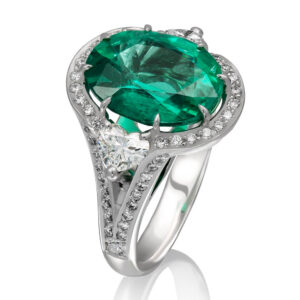What Is the Birthstone for February?
What Is the Birthstone for January?Meaning BehindMetals That Best ComplementThe Symbolism of Gifting or ReceivingThe...

Emeralds’ alluring green hue has captured the imagination of humans for a millennium. Their long and storied history begins in Egypt around 330 BC. The Egyptian pharaoh Cleopatra adored emeralds so much that she frequently wore them as jewellery.
Emeralds were commonly utilised by the ancient Egyptians in talismans in the belief that they represented rebirth, fertility, and the afterlife. In Roman mythology, Venus, goddess of love, beauty, and fertility, was linked to emeralds. It was thought that emeralds would bestow their wearers with a greater capacity for love, passion, and loyalty. In this article, we’ll look into how you can design your own bespoke emerald ring.
Before you start exploring custom-made jewellery in Melbourne, clearly understand what you want your emerald ring to look like. Fashion magazines are a great place to find trends. You can find ring designs ranging from simple and subtle, to striking and attention-grabbing. Vogue, Harper’s Bazaar, Elle, InStyle, and Marie Claire are just a few of the many prominent fashion publications that regularly showcase jewellery collections. The online magazine, The Jewelry Editor, also showcases the newest offerings from high-end jewellery manufacturers and designers.
The most valuable emeralds boast a deep green colour and excellent clarity. It’s important to consider how the gemstone’s cut will affect the ring’s overall appearance. The “Four Cs” (colour, clarity, cut, and carat weight) are the most important factors to evaluate when shopping for an emerald.
The most important criterion in judging the quality of an emerald is its colour. The most precious emeralds have a bright, vivid, deep green colour. Emerald colour is assessed using three criteria: hue, saturation, and tone.
The hue of an emerald refers to its predominant colour, which should ideally be green with no indications of yellow or blue. The intensity, or purity, of the colour is known as its saturation. High-quality emeralds have high saturation, which means their colour is vivid and pure, with no indications of grey or brown. Tone is the degree of brightness or darkness of a colour. Desirable emeralds have a medium to dark tone that adds to their overall beauty.
Emeralds often have internal imperfections or “inclusions.” These inclusions are sometimes referred to as “jardin,” which is French for “garden.” The imperfections can actually add to their unique character and appeal; however, when assessing clarity, you should consider the number, size, and location of inclusions. High-quality emeralds contain fewer apparent imperfections that do not distract from the overall brilliance of the gemstone.
The cut of an emerald has a significant impact on its overall look and value. A well-cut emerald maximises colour and minimises inclusions while boosting its brilliance and scintillation. The emerald, oval, and cushion cuts are all popular emerald cuts. When evaluating the cut, consider the gemstone’s symmetry, proportions, and polish.
The carat weight of an emerald also influences its value–larger emeralds are more precious and rarer than smaller ones. However, in addition to size, the quality of the gemstone must be considered. A smaller emerald with excellent colour and clarity may be worth more than a bigger one with poor colour or significant inclusions.
Setting is the method of securing a gemstone into place. The setting secures the gemstone and contributes significantly to the overall aesthetics and style of the jewellery, and the shape and size of the gemstone might influence the setting.
Some settings work better with certain shapes or sizes, ensuring a secure fit. A bezel setting, for example, is ideal for round or oval gemstones, but a prong setting may handle a variety of forms. Prong, bezel, halo, and channel settings are popular emerald ring settings.
Emeralds are versatile gemstones that look great with a variety of metal bands.
For emerald jewellery, yellow gold is a traditional and timeless choice. The warm, rich tone of yellow gold contrasts sharply with the vivid green colour of emeralds. This combination is frequently encountered in timeless and antique jewellery, and it remains popular among people who seek a conventional and beautiful appearance.
Due to its sleek and refined appearance, white gold has become more popular for emerald jewellery. White gold’s silvery tone creates a neutral backdrop for the emerald’s green colour to stand out. White gold is an alloy of gold and other white metals such as palladium, nickel, or silver, and it is sometimes coated with rhodium to increase durability and lustre.
Another popular alternative for emerald jewellery is platinum, especially for those looking for a more durable and hypoallergenic option. The cool, argent tint of platinum, like white gold, complements the green colour of emeralds. Platinum is a more costly metal than gold because it is rare and dense, but its durability and resistance to wear makes it a worthy investment.
Emeralds have long been admired for their beauty and their perceived magical abilities–they are believed to bring good fortune and protect those who wear them from harm. Whatever the specific symbolism, one thing is certain: emeralds’ allure has remained consistent throughout the ages, making them one of the most cherished and timeless gemstones in the world.
Holloway Diamonds is the perfect choice for those seeking bespoke jewellery such as unique sapphire engagement rings. With our exceptional craftsmanship and attention to detail, we are committed to bringing your dream ring into reality. Want to learn more about what a bespoke engagement ring is? Visit our store and talk to our experts today!
What Is the Birthstone for January?Meaning BehindMetals That Best ComplementThe Symbolism of Gifting or ReceivingThe...
What Is the Birthstone for January?Meaning BehindMetals That Best ComplementThe Symbolism of Gifting or ReceivingThe...
IntroductionWhat Drives Engagement Ring CostsHow Much Should an Engagement Ring CostPreparing for the Day of...